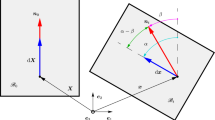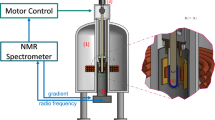Abstract
Using the spin Hamiltonian method, we have studied the dynamic instability of quasi-one-dimensional spin chains, which are models of the corresponding conjugated polymers. We have considered the example of chain deformation leading to a singular response of the original one-dimensional problem. We have formulated the conditions for activationless character of excitations having multiplicity of the ground state.
Similar content being viewed by others
Literature cited
L. N. Bulaevskii, “Qausihomopolar electron levels in crystals and molecules,” Zh. Éksp. Teor. Fiz., 51, No. 1, 230–239 (1966).
A. A. Ovchinnikov and V. O. Cheranovskii, “Perturbation theory in the Spin Hamiltonian Method,” Teor. Éksp. Khim., 16, No. 2, 147–153 (1980).
I. A. Misurkin and A. A. Ovchinnikov, “Electron structure and properties of polymer molecules with conjugated bonds,” Usp. Khim., 46, No. 10, 1835–1870 (1977).
V. O. Cheranovskii, “Recyclization reactions in a multielectron treatment,” Teor. Éksp. Khim., 17, No. 1, 21–27 (1981).
M. M. Mestechkin and A. G. Gershikov, “Virial theorem for the adiabatic potential and dynamic instability of polyatomic molecules,” 9th All-Union Conference on Quantum Chemistry: Abstracts, Ivanova, July 10–12, 1985 [in Russian], B. I., Chernogolovka (1985), Pt. 1, pp. 41–42.
P. Lancaster, Theory of Matrices [Russian translation], Nauka, Moscow (1978).
H. Bethe, “Theory of metals. Properties and eigenfunctions of linear atomic chains,” Z. Phys., 71, No. 8, 205–226 (1931).
J. Des Cloizeaux and J. J. Pearson, “Spin-wave spectrum of the antiferromagnetic linear chain,” Phys. Rev., 128, No. 5, 2131–2135 (1962).
A. A. Ovchinnikov, “Excitation spectrum of the antiferromagnetic Heisenberg chain,” Zh. Éksp. Teor. Fiz., 56, No. 4, 1354–1365 (1969).
L. A. Takhtadzhyan and L. D. Faddeev, “Spectrum and scattering of excitations in a one-dimensional isotropic Heisenberg magnet,” Zap. Nauch. Sem. Mat. Inst. im. V. A. Steklova Akad. Nauk SSSR, 109, 134–178 (1981).
D. J. Klein, “Exact ground states for a class of antiferromagnetic Heisenberg models with short-range interactions,” J. Phys. A, 15, No. 2, 661–671 (1982).
W. J. Caspers, “Exact ground states for a class of linear antiferromagnetic spin systems,” Physica A, 115, No. 1/2, 275–280 (1982).
L. N. Bulaevskii, “Theory of an inhomogeneous antiferromagnetic spin chain,” Zh. Éksp. Teor. Fiz., 44, No. 3, 1008–1013 (1963).
T. W. Ruijgrok and S. Rodriguez, “Linear antiferromagnetic chain,” Phys. Rev., 119, No. 2, 596–599 (1961).
Z. G. Soos, “Theory of linear Heisenberg antiferromagnet. Application to paramagnetic excitations in organic crystals,” J. Chem. Phys., 43, No. 4, 1121–1140 (1965).
K. A. Hashimoto, “A theoretical estimate for quasihomopolar singlet levels in long polyenes with a spin model Hamiltonian,” Chem. Phys., 80, No. 3, 253–261 (1983).
J. M. Rabin, “Renormalization group studies of antiferromagnetic chains. 1. Nearest-neighbor interactions,” Phys. Rev. B, 21, No. 5, 2027–2037 (1980).
D. J. Klein and M. A. Garcia-Bach, “Variational localized-site cluster expansions. 10. Dimerization in linear Heisenberg chains,” Phys. Rev. B, 19, No. 2, 877–886 (1979).
E. Lieb, T. Shultz, and D. Mattis, “Two soluble models of an antiferromagnetic chain,” Ann. Phys., 16, No. 3, 407–466 (1961).
A. A. Ovchinnikov and V. O. Cheranovskii, “Excitation spectrum of magnetic alternant chains with odd number of atoms in the elementary unit,” Dokl. Akad. Nauk SSSR, 266, No. 4, 838–840 (1982).
E. Lieb and D. Mattis, “Ordering energy levels of interacting spin systems,” J. Math. Phys., 3, No. 4, 749–751 (1962).
A. A. Ovchinnikov, “Multiplicity of the ground state of large alternant organic molecules with conjugated bonds,” Theor. Chim. Acta, 47, No. 4, 297–304 (1978).
A. B. Harris, “Alternating linear Heisenberg antiferromagnet: the exciton limit,” Phys. Rev. B, 7, No. 7, 3166–3187 (1973).
V. O. Cheranovskii, “Quantum chemical study of conjugated systems with high spin multiplicity and hetero aroms in a conjugation chain,” Author's Abstract of Candidate's Dissertation, Chemical Sciences, Moscow (1981).
W. Grieger, “Ground state of the isotropic one-dimensional Heisenberg antiferromagnet,” Phys. Rev. B, 30, No. 1, 344–347 (1984).
Author information
Authors and Affiliations
Additional information
Translated from Teoreticheskaya i Éksperimental'naya Khimiya, Vol. 23, No. 4, pp. 395–401, July–August, 1987.
The author expresses thanks to A. A. Ovchinnikov for discussion of the results of the work.
Rights and permissions
About this article
Cite this article
Cheranovskii, V.O. Spectrum of quasihomopolar states and dynamic instability of polymer chains with conjugated bonds. Theor Exp Chem 23, 368–374 (1988). https://doi.org/10.1007/BF00536352
Received:
Issue Date:
DOI: https://doi.org/10.1007/BF00536352




